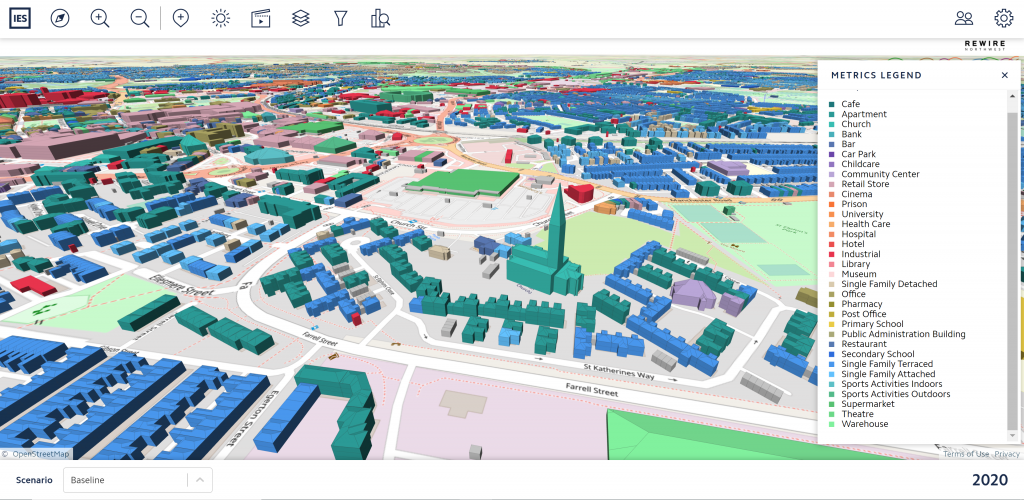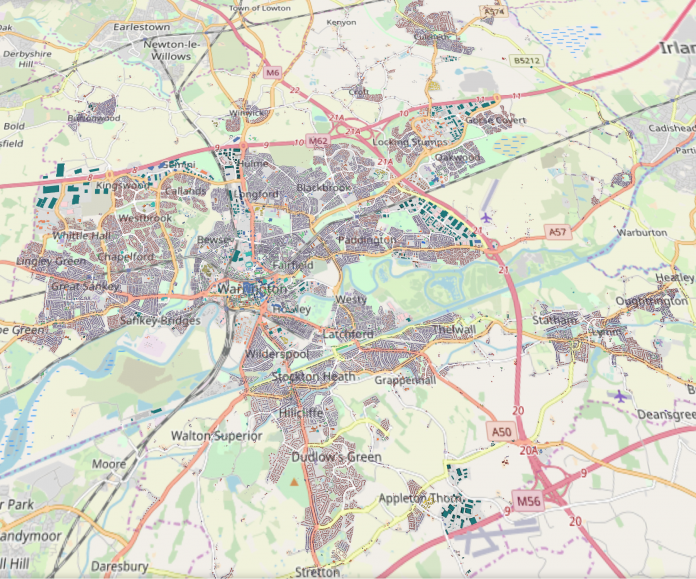The Innovate UK-funded REWIRE project has created a virtual digital twin of Warrington in north-west England to help identify where carbon and efficiency savings can be made across the town’s buildings and energy systems
The energy crisis, decarbonisation targets and the increasing impact of climate change are all factors that have pushed energy management higher up the priority list for councils. More than 300 local authorities have declared a climate emergency and many are seeking ways to reach ambitious 2030 net zero targets.
One area in which councils are looking to make savings and reduce their environmental impact is through the built environment. Facilities owned and managed by local authorities, as well as all those within the borough, hold significant potential to reduce emissions. With the built environment contributing over 40% of all carbon emissions in the UK, finding ways to reduce this impact is fundamental to meeting sustainability goals.
Utilising the technology available is key to beginning the decarbonisation journey. For example, digital twin technology, which allows for the creation of live virtual replicas of physical buildings and communities that behave as their real-world counterparts would. From these models, accurate building data can be gathered to understand where energy is being used, wasted and can be saved through evidence backed building improvements. Digital twin technology moves beyond BIM to enable the replication of multiple buildings and communities, and allow for models to evolve across the whole building lifecycle, including into operation.
One example of a council that has employed the use of technology to create tangible change is Warrington Borough Council.
Warrington’s virtual digital twin
As part of a REWIRE project funded by Innovate UK, a virtual digital twin of Warrington has been created. This model has enabled the council to identify which energy, carbon and cost-efficiency measures are required across the town’s buildings and energy systems to deliver a net zero future.

Consultants from IES worked with the council to develop the model of the borough, which is made up of 29 separate areas. Data from the council, the Energy Performance Certificate (EPC) database and local distribution network operators was utilised in the creation of the digital twin. This data included information around building use and age, characteristics, and electric network infrastructures.
Once gathered, the information from all 29 areas was modelled individually in IES’s Intelligent Community Design (iCD) tool. This technology enables the council to analyse and monitor how Warrington may evolve over time and evaluate the environmental impact of changes such as population growth or the installation of renewable energy systems. All 29 models were then collated into one single virtual digital twin of the whole borough.
Identifying the best retrofitting options for neighbourhoods in the borough
This was achieved by using the EPC data to gather information on 50,000 residential properties within Warrington, such as build characteristics, heating systems and age. Models were then created of the four main types of homes and utilised to provide a holistic view of the area, integrating electricity, heating, cooling, waste heat networks and shared energy links across buildings.
Various retrofitting scenarios were then tested in the models, from cavity wall and loft insulation to full building upgrades, such as improved glazing and reduced infiltration rates of outside air. Significant savings were identified, for example, the basic retrofit of one neighbourhood would cost around £500,000 to implement, saving £77,000 in energy costs over the 500 buildings, and paying itself back in six-and-a-half years.
Digital twin technology helps assess decarbonisation approaches
The digital twin technology also allowed for the assessment of different approaches to achieve full decarbonisation of the district. The optimal solutions for decarbonising two different neighbourhoods, comprising of around 500 homes, were identified and potential energy savings of up to 56% were unlocked. Suggested measures included the installation of domestic and commercial air source heat pumps and district heating.
Using the virtual digital twin simulation of two neighbourhoods within the borough, it was demonstrated that once all interventions were applied, an annual saving of 2,000-2,500 tonnes of CO2 would be possible. This would result in both these neighbourhoods becoming net zero with only a very small amount of carbon offsetting required.
Bespoke pathways to net zero
In this case, the use of digital twin technology has enabled the creation of bespoke pathways to net zero, as well as provided the council with the ability to see all possible optimisation scenarios and understand the potential return on investment for associated decarbonisation initiatives. At a time when budgets are being stretched to the limit, technology enables the quantification of energy-saving measures, supporting councils to take control of energy management and make informed decisions around retrofitting, renewable energy resources and energy networks.
As time runs out to meet climate commitments, all those with a stake in the built environment must be utilising technology to create tangible change. Furthermore, as energy costs look set to be a continued pain point, those that invest in improvements now will reap the benefits in the near future.
Valeria Ferrando

Associate director, ICL Consultancy
IES
Tel: +44 (0) 141 945 8500














